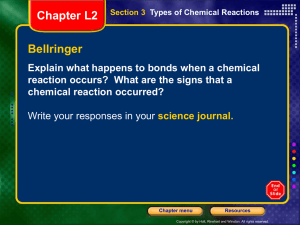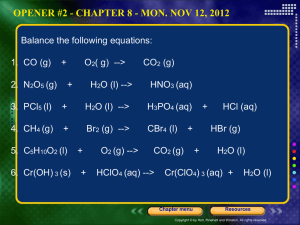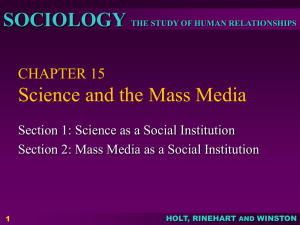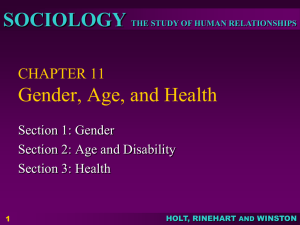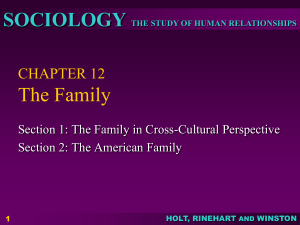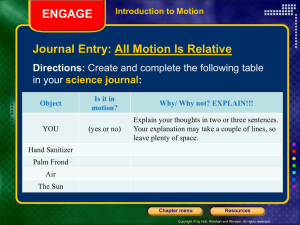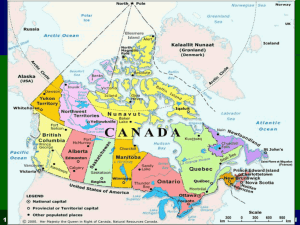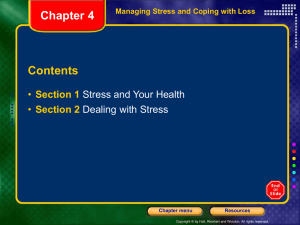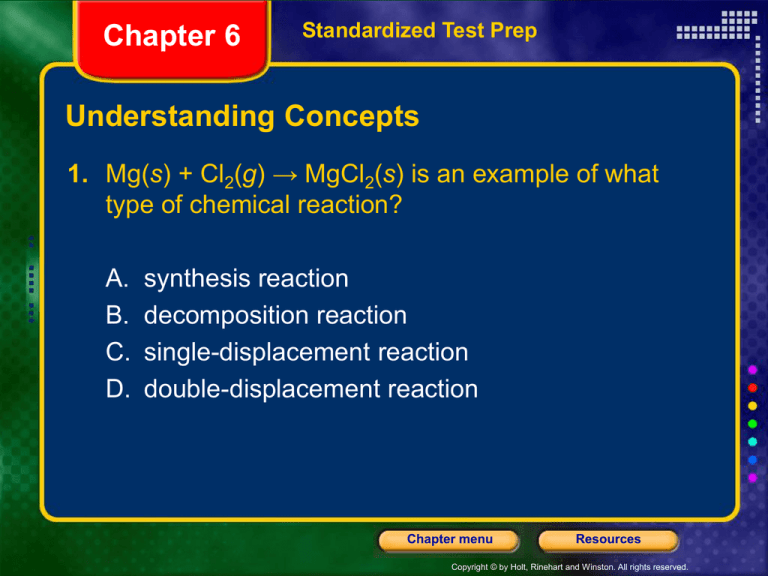
Chapter 6
Standardized Test Prep
Understanding Concepts
1. Mg(s) + Cl2(g) → MgCl2(s) is an example of what
type of chemical reaction?
A.
B.
C.
D.
synthesis reaction
decomposition reaction
single-displacement reaction
double-displacement reaction
Chapter menu
Resources
Copyright © by Holt, Rinehart and Winston. All rights reserved.
Chapter 6
Standardized Test Prep
Understanding Concepts
1. Mg(s) + Cl2(g) → MgCl2(s) is an example of what
type of chemical reaction?
A.
B.
C.
D.
synthesis reaction
decomposition reaction
single-displacement reaction
double-displacement reaction
Chapter menu
Resources
Copyright © by Holt, Rinehart and Winston. All rights reserved.
Chapter 6
Standardized Test Prep
Understanding Concepts
2. Which of the following changes will not increase the
rate of a chemical reaction?
F.
G.
H.
I.
using an enzyme in a reaction
adding an inhibitor to the reaction mixture
increasing the concentration of the reactants
grinding a solid reactant to make a fine powder
Chapter menu
Resources
Copyright © by Holt, Rinehart and Winston. All rights reserved.
Chapter 6
Standardized Test Prep
Understanding Concepts
2. Which of the following changes will not increase the
rate of a chemical reaction?
F.
G.
H.
I.
using an enzyme in a reaction
adding an inhibitor to the reaction mixture
increasing the concentration of the reactants
grinding a solid reactant to make a fine powder
Chapter menu
Resources
Copyright © by Holt, Rinehart and Winston. All rights reserved.
Chapter 6
Standardized Test Prep
Understanding Concepts
3. Which of the following is an endothermic chemical
reaction?
A.
B.
C.
D.
fireworks exploding in the sky
photosynthesis in plant cells
respiration in animal cells
wood burning in a fireplace
Chapter menu
Resources
Copyright © by Holt, Rinehart and Winston. All rights reserved.
Chapter 6
Standardized Test Prep
Understanding Concepts
3. Which of the following is an endothermic chemical
reaction?
A.
B.
C.
D.
fireworks exploding in the sky
photosynthesis in plant cells
respiration in animal cells
wood burning in a fireplace
Chapter menu
Resources
Copyright © by Holt, Rinehart and Winston. All rights reserved.
Chapter 6
Standardized Test Prep
Understanding Concepts
4. Most chemical reactions proceed faster if the
reactants are heated. How does the added heat
affect reactant atoms or molecules?
Chapter menu
Resources
Copyright © by Holt, Rinehart and Winston. All rights reserved.
Chapter 6
Standardized Test Prep
Understanding Concepts
4. Most chemical reactions proceed faster if the
reactants are heated. How does the added heat
affect reactant atoms or molecules?
Answer: Addition of heat causes the particles to move
faster and collide more often. The increase in
collisions speeds up the reaction.
Chapter menu
Resources
Copyright © by Holt, Rinehart and Winston. All rights reserved.
Chapter 6
Standardized Test Prep
Understanding Concepts
5. The reaction of glucose and oxygen to form carbon
dioxide and water produces the same amount of
energy inside living cells as it does by combustion.
Analyze how this reaction can occur at body
temperature in the cells, but not in the open air.
Chapter menu
Resources
Copyright © by Holt, Rinehart and Winston. All rights reserved.
Chapter 6
Standardized Test Prep
Understanding Concepts
5. The reaction of glucose and oxygen to form carbon
dioxide and water produces the same amount of
energy inside living cells as it does by combustion.
Analyze how this reaction can occur at body
temperature in the cells, but not in the open air.
Answer: Inside living cells, enzymes act as catalysts to
reduce the amount of energy needed to start the
reaction and to allow it to proceed at a lower
temperature.
Chapter menu
Resources
Copyright © by Holt, Rinehart and Winston. All rights reserved.
Chapter 6
Standardized Test Prep
Reading Skills
Some metals react with water to form new compounds
by displacing hydrogen from water molecules. Alkali
metals are sufficiently reactive that this chemical
reaction happens at room temperature. If a piece of
cesium is placed in water, an explosion occurs as the
hydrogen gas reacts with oxygen in
the air.
continued on next slide
Chapter menu
Resources
Copyright © by Holt, Rinehart and Winston. All rights reserved.
Chapter 6
Standardized Test Prep
Reading Skills
6. Hydrogen and oxygen gases do not react
spontaneously when they are mixed, unless energy
is added to start the reaction. What is the source of
energy that causes hydrogen to react explosively
when cesium is added to water?
Chapter menu
Resources
Copyright © by Holt, Rinehart and Winston. All rights reserved.
Chapter 6
Standardized Test Prep
Reading Skills
6. Hydrogen and oxygen gases do not react
spontaneously when they are mixed, unless energy
is added to start the reaction. What is the source of
energy that causes hydrogen to react explosively
when cesium is added to water?
Answer: The reaction of cesium and water is extremely
exothermic. This exothermic reaction provides the
energy to initiate the reaction between hydrogen
and oxygen.
Chapter menu
Resources
Copyright © by Holt, Rinehart and Winston. All rights reserved.
Chapter 6
Standardized Test Prep
Interpreting Graphics
7. In each of these reactions, the chemical energy increases and
then decreases, during the course of the reaction. What does
the height of the “hill” on each graph represent?
F. energy that must be added to start the reaction
G. energy released as reactant molecules approach one
another
H. the potential energy of the chemical bonds in the molecules
of the reactants
I. The change in total chemical energy between the reactants
and the products
Chapter menu
Resources
Copyright © by Holt, Rinehart and Winston. All rights reserved.
Chapter 6
Standardized Test Prep
Interpreting Graphics
7. In each of these reactions, the chemical energy increases and
then decreases, during the course of the reaction. What does
the height of the “hill” on each graph represent?
F. energy that must be added to start the reaction
G. energy released as reactant molecules approach one
another
H. the potential energy of the chemical bonds in the molecules
of the reactants
I. The change in total chemical energy between the reactants
and the products
Chapter menu
Resources
Copyright © by Holt, Rinehart and Winston. All rights reserved.

